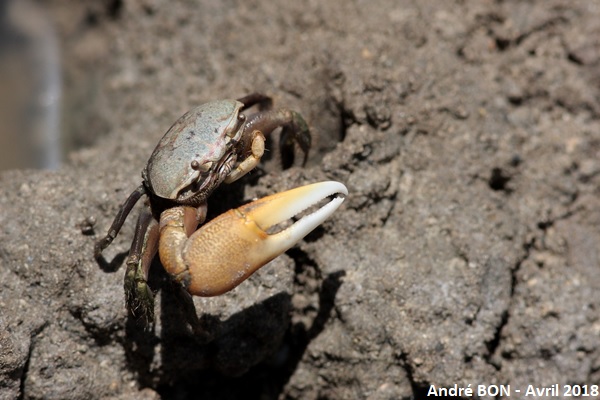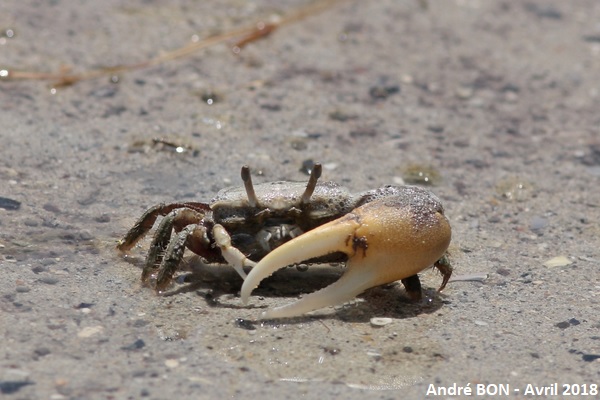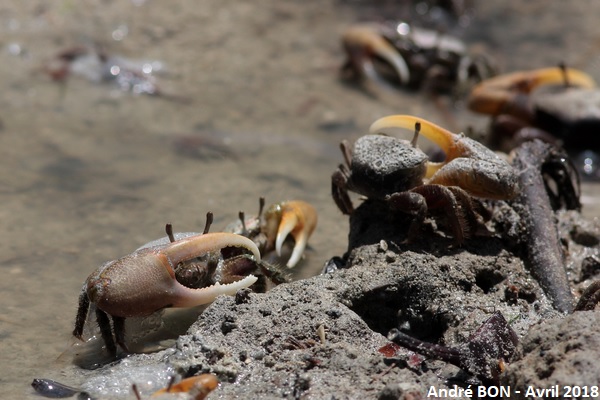




| Mudflat Fiddler Crab (Minuca rapax (Smith, 1870)) |





|
|
Scientific name: Minuca rapax (Smith, 1870) Common name: Mudflat Fiddler Crab Other names: Old scientific name: Uca rapax (the Minuca subgenus was raised at the genus level in 2016). French name: Crabe violoniste des vasières, Crabe sémafot. Order: Decapoda Family: Ocypodidae Size: Carapace: 21 mm long and 32 mm wide for males, 17 mm long and 27 mm wide for females. Habitat : Mangroves, bays, mudflats. Food: Micro-algae and organic debris collected with the small, flattened, bristle-lined claw. The large claw of the males is used to attract females and to defend the territory. Reproduction : Males dig burrows the width of which is equal to that of their large claw. This claw is waved to attract females. The importance of the tides influences the choice of females because it determines the optimal size of the burrows. After mating females lay their eggs at the bottom of the burrow. The eggs remain attached to females and are released after a gestation period of about two weeks. Geographic area: American Atlantic coast, from Florida to southern Brazil. West Indies. |
The Ocypodidae is a family of semi-terrestrial crabs living on the sea coasts of tropical and temperate regions. It includes Fiddler Crabs, Ghost Crabs (Ocypode genus) and Mangrove Crabs (Ucides genus). Fiddler Crabs live in large colonies in open intertidal areas where you can see them at low tide. Males have a huge claw that sits either on the right or left with roughly equal numbers of right- and left-handers. Females have two small claws. If the claw is lost, it grows back during the moult period. Fiddler Crabs live in burrows from which they emerge at low tide and where they take refuge at high tide after plugging the opening with earth. There are more than a hundred species in the world. Here are some non-exhaustive characteristics of the Mudflat Fiddler Crab (Minuca rapax). It has a pentagonal carapace with moderately arched edges. This carapace is cream or light brown in colour. The large claw is yellowish with white fingers. The legs are brown. The frontal triangle that descends between the eyes is quite wide and occupies about a third of the inter-orbital distance. The merus of the last legs is distinctly convex in shape and its greatest width is more than twice that of the carpus. |
| [To know more about the Mudflat Fiddler Crab] [Next picture] [Top] |

|
My lack of experience and the difficulty in evaluating the criteria of the identification keys on a photo caused me great difficulty in determining the species of these fiddler crabs observed during a hike on the Caravelle peninsula near the Baie du Trésor. So the identification of the species comes from scientific documents describing the biodiversity of this place and which seemed trustworthy to me (source: 2013-2017 Management plan of the Caravelle Nature Reserve - August 2013 - ONF Martinique). Here is a male with its large claw. |
| [To know more about the Mudflat Fiddler Crab] [Next picture] [Previous picture] [Top] |

|
Here is another male. The previous one was left-handed, this one is right-handed. It is very close to its burrow. |
| [To know more about the Mudflat Fiddler Crab] [Next picture] [Previous picture] [Top] |

|
Here is another photo of a male. I realized afterwards that I have no photo of females. I don't know if it's because I was attracted by the ballet of the large claws or if it's because there were few or no females visible. |
| [To know more about the Mudflat Fiddler Crab] [Next picture] [Previous picture] [Top] |

|
Here is a slightly larger view that shows the density of males showing off their large claws. |
| [To know more about the Mudflat Fiddler Crab] [Previous picture] [Top] |

|
This back view shows that the merus of the last pair of legs is convex in shape and that its greatest width is more than twice that of the carpus. All the other identification criteria that I could see, colour of the body, of the legs, of the large claw of the males match well the Minuca rapax species. |